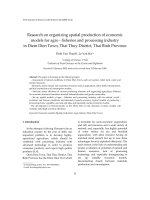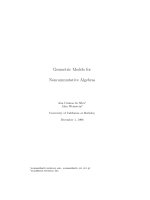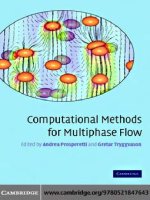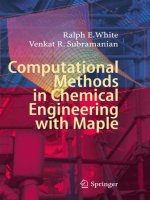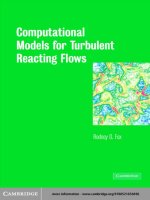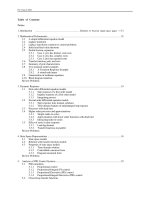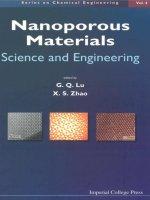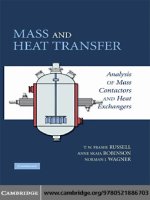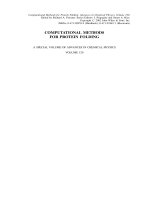computational models for turbulent reacting flows cambridge series in chemical engineering
Bạn đang xem bản rút gọn của tài liệu. Xem và tải ngay bản đầy đủ của tài liệu tại đây (3.54 MB, 439 trang )
This page intentionally left blank
Computational Models for Turbulent Reacting Flows
This book presents the current state of the art in computational models for turbulent reacting
flows, and analyzes carefully the strengths and weaknesses of the various techniques
described. The focus is on formulation of practical models as opposed to numerical issues
arising from their solution.
A theoretical framework based on the one-point, one-time joint probability density
function (PDF) is developed. It is shown that all commonly employed models for turbulent reacting flows can be formulated in terms of the joint PDF of the chemical species and
enthalpy. Models based on direct closures for the chemical source term as well as transported PDF methods, are covered in detail. An introduction to the theory of turbulence
and turbulent scalar transport is provided for completeness.
The book is aimed at chemical, mechanical, and aerospace engineers in academia and
industry, as well as developers of computational fluid dynamics codes for reacting flows.
r o d n e y o . f o x received his Ph.D. from Kansas State University, and is currently the
Herbert L. Stiles Professor in the Chemical Engineering Department at Iowa State University. He has held visiting positions at Stanford University and at the CNRS Laboratory
in Rouen, France, and has been an invited professor at ENSIC in Nancy, France; Politecnico di Torino, Italy; and Aalborg University, Denmark. He is the recipient of a National
Science Foundation Presidential Young Investigator Award, and has published over 70
scientific papers.
C AMB R IDGE S E RIE S IN CHE M IC AL ENG INEERING
Series Editor:
Arvind Varma, University of Notre Dame
Editorial Board:
Alexis T. Bell, University of California, Berkeley
John Bridgwater, University of Cambridge
L. Gary Leal, University of California, Santa Barbara
Massimo Morbidelli, ETH, Zurich
Stanley I. Sandler, University of Delaware
Michael L. Schuler, Cornell University
Arthur W. Westerberg, Carnegie-Mellon University
Titles in the Series:
Diffusion: Mass Transfer in Fluid Systems, Second Edtion, E. L. Cussler
Principles of Gas-Solid Flows, Liang-Shih Fan and Chao Zhu
Modeling Vapor-Liquid Equilibria: Cubic Equations of State and their Mixing Rules,
Hasan Orbey and Stanley I. Sandler
Advanced Transport Phenomena, John C. Slattery
Parametric Sensitivity in Chemical Systems, Arvind Varma, Massimo Morbidelli and
Hua Wu
Chemical Engineering Design and Analysis, T. Michael Duncan and Jeffrey A. Reimer
Chemical Product Design, E. L. Cussler and G. D. Moggridge
Catalyst Design: Optimal Distribution of Catalyst in Pellets, Reactors, and Membranes,
Massimo Morbidelli, Asterios Gavriilidis and Arvind Varma
Process Control: A First Course with MATLAB, Pao C. Chau
Computational Models for Turbulent Reacting Flows, Rodney O. Fox
Computational Models for Turbulent
Reacting Flows
Rodney O. Fox
Herbert L. Stiles Professor of Chemical Engineering
Iowa State University
Cambridge, New York, Melbourne, Madrid, Cape Town, Singapore, São Paulo
Cambridge University Press
The Edinburgh Building, Cambridge , United Kingdom
Published in the United States of America by Cambridge University Press, New York
www.cambridge.org
Information on this title: www.cambridge.org/9780521650496
© Cambridge University Press 2003
This book is in copyright. Subject to statutory exception and to the provision of
relevant collective licensing agreements, no reproduction of any part may take place
without the written permission of Cambridge University Press.
First published in print format 2003
-
-
---- eBook (EBL)
--- eBook (EBL)
-
-
---- hardback
--- hardback
-
-
---- paperback
--- paperback
Cambridge University Press has no responsibility for the persistence or accuracy of
s for external or third-party internet websites referred to in this book, and does not
guarantee that any content on such websites is, or will remain, accurate or appropriate.
`
a Roberte
Contents
Preface
1 Turbulent reacting flows
1.1 Introduction
page xiii
1
1
1.2 Chemical-reaction-engineering approach
1.2.1 PFR and CSTR models
1.2.2 RTD theory
1.2.3 Zone models
1.2.4 Micromixing models
1.2.5 Micromixing time
3
5
8
10
12
14
1.3 Fluid-mechanical approach
1.3.1 Fundamental transport equations
1.3.2 Turbulence models
1.3.3 Chemical source term
1.3.4 Molecular mixing
15
16
17
18
23
1.4 Relationship between approaches
24
1.5 A road map to Chapters 2–7
25
2 Statistical description of turbulent flow
2.1 Homogeneous turbulence
2.1.1 One-point probability density function
2.1.2 Spatial correlation functions
2.1.3 Temporal correlation functions
2.1.4 Turbulent energy spectrum
2.1.5 Model velocity spectrum
2.1.6 Spectral transport
27
27
29
32
34
36
39
41
vii
viii
Contents
2.2 Inhomogeneous turbulence
2.2.1 Expected values of derivatives
2.2.2 Mean velocity
2.2.3 Reynolds stresses
2.2.4 Turbulent dissipation rate
3 Statistical description of turbulent mixing
44
45
47
48
51
56
3.1 Phenomenology of turbulent mixing
3.1.1 Length scales of turbulent mixing
3.1.2 Phenomenological model for turbulent mixing
56
57
58
3.2 Homogeneous turbulent mixing
3.2.1 One-point velocity, composition PDF
3.2.2 Conditional velocity and scalar statistics
3.2.3 Spatial correlation functions
3.2.4 Scalar energy spectrum
3.2.5 Model scalar spectrum
3.2.6 Scalar spectral transport
62
62
67
69
71
73
78
3.3 Inhomogeneous turbulent mixing
3.3.1 Scalar mean
3.3.2 Scalar flux
3.3.3 Scalar variance
3.3.4 Scalar dissipation rate
3.3.5 Scalar covariance
3.3.6 Joint scalar dissipation rate
80
81
82
84
86
90
92
3.4 Differential diffusion
3.4.1 Homogeneous turbulence
3.4.2 Mean scalar gradients
3.4.3 Decaying scalars
96
97
98
98
4 Models for turbulent transport
100
4.1 Direct numerical simulation
4.1.1 Homogeneous turbulence
4.1.2 Reacting flow
100
101
102
4.2 Large-eddy simulation
4.2.1 Filtered Navier–Stokes equation
4.2.2 LES velocity PDF
4.2.3 Scalar transport
4.2.4 Reacting flow
104
104
106
108
109
4.3 Linear-eddy model
4.3.1 Homogeneous flows
4.3.2 Inhomogeneous flows
110
111
113
ix
Contents
4.4 RANS turbulence models
4.4.1 Turbulent-viscosity-based models
4.4.2 Reynolds-stress transport equation
114
114
117
4.5 RANS models for scalar mixing
4.5.1 Turbulent-diffusivity-based models
4.5.2 Scalar-flux transport equation
4.5.3 Scalar-variance transport equation
4.5.4 Scalar-dissipation transport equation
120
121
123
125
126
4.6 Non-equilibrium models for scalar dissipation
4.6.1 Spectral relaxation model
4.6.2 Spectral transfer rates
4.6.3 Extensions of the SR model
127
128
132
135
4.7 Models for differential diffusion
4.7.1 Multi-variate SR model
4.7.2 Mean scalar gradients
4.7.3 Decaying scalars
135
135
137
138
4.8 Transported PDF methods
140
5 Closures for the chemical source term
141
5.1 Overview of the closure problem
5.1.1 Chemical source term
5.1.2 Elementary reactions
5.1.3 Non-elementary reactions
5.1.4 Reynolds-averaged chemical source term
5.1.5 Chemical time scales
141
142
144
146
150
151
5.2 Moment closures
5.2.1 First-order moment closures
5.2.2 Higher-order moment closures
153
153
155
5.3 Mixture-fraction vector
5.3.1 General formulation
5.3.2 Definition of mixture fraction
5.3.3 Example flows
5.3.4 Mixture-fraction PDF
156
157
161
168
174
5.4 Equilibrium-chemistry limit
5.4.1 Treatment of reacting scalars
5.4.2 Application to turbulent reacting flows
177
177
178
5.5 Simple chemistry
5.5.1 General formulation: reaction-progress variables
5.5.2 One-step reaction
5.5.3 Competitive-consecutive reactions
5.5.4 Parallel reactions
180
181
182
184
189
x
Contents
5.6
Lagrangian micromixing models
5.6.1 IEM model for a stirred reactor
5.6.2 Age-based models
5.6.3 Lagrangian models for the micromixing rate
5.6.4 Mechanistic models
5.6.5 Extension to inhomogeneous flows
193
194
195
197
198
200
5.7
Laminar diffusion flamelets
5.7.1 Definition of a flamelet
5.7.2 Stationary laminar flamelet model
5.7.3 Joint mixture fraction, dissipation rate PDF
5.7.4 Extension to inhomogeneous flows
201
201
204
205
206
5.8
Conditional-moment closures
5.8.1 General formulation: conditional moments
5.8.2 Closures based on presumed conditional moments
5.8.3 Conditional scalar mean: homogeneous flow
5.8.4 Conditional scalar dissipation rate
5.8.5 Extension to inhomogeneous flows
207
207
209
211
212
214
5.9
Presumed PDF methods
5.9.1 Single reaction-progress variable
5.9.2 Multiple reaction-progress variables
216
216
218
5.10 Multi-environment presumed PDF models
5.10.1 General formulation
5.10.2 Extension to inhomogeneous flows
5.10.3 Multi-environment conditional PDF models
5.10.4 Extension to LES
221
222
226
233
237
5.11 Transported PDF methods
239
6 PDF methods for turbulent reacting flows
241
6.1
Introduction
6.1.1 Velocity, composition PDF
6.1.2 Composition PDF
241
242
244
6.2
Velocity, composition PDF transport equation
6.2.1 Mean convected derivative: first form
6.2.2 Mean convected derivative: second form
6.2.3 Joint PDF transport equation: final form
6.2.4 Conditional fluxes: the unclosed terms
244
245
246
248
248
6.3
Composition PDF transport equation
6.3.1 Derivation of transport equation
6.3.2 Scalar-conditioned velocity fluctuations
6.3.3 Relationship to Lagrangian micromixing models
249
249
251
251
xi
Contents
6.4
Relationship to RANS transport equations
6.4.1 RANS mean velocity transport equation
6.4.2 Reynolds-stress transport equation
252
252
254
6.5
Models for conditional acceleration
6.5.1 Velocity PDF: decoupling from the scalar field
6.5.2 Velocity PDF closures
6.5.3 Corresponding Reynolds-stress models
6.5.4 Generalized Langevin model
6.5.5 Extension to velocity, composition PDF
6.5.6 Coupling with mean pressure field
6.5.7 Wall boundary conditions for velocity PDF
6.5.8 Large-eddy PDF methods
6.5.9 Velocity, wavenumber PDF models
254
255
255
256
257
258
259
260
260
261
6.6
Models for conditional diffusion
6.6.1 Some useful constraints
6.6.2 Desirable properties for mixing models
6.6.3 Physical basis for desirable properties
6.6.4 Three simple mixing models
6.6.5 Prospects for mixing model improvements
261
262
263
264
273
286
6.7
Lagrangian PDF methods
6.7.1 Lagrangian notional particles
6.7.2 Lagrangian fluid particles
6.7.3 Spatial distribution of notional particles
6.7.4 Relationship to Eulerian PDF transport equation
6.7.5 Stochastic differential equations for notional particles
6.7.6 Lagrangian velocity PDF closures
6.7.7 Lagrangian mixing models
287
287
289
290
290
292
294
296
6.8
Particle-field estimation
6.8.1 Notional particles
6.8.2 Empirical PDF
6.8.3 Errors in mean-field estimate
6.8.4 PDF estimation
298
298
300
302
307
6.9
Chemical source term
6.9.1 Stiff kinetics
6.9.2 Decoupling from transport terms
6.9.3 Pre-computed lookup tables
6.9.4 In situ adaptive tabulation
308
308
309
310
312
6.10 Higher-order PDF models
6.10.1 Turbulence frequency
6.10.2 Lagrangian SR model
321
321
322
xii
Contents
6.10.3 LSR model with differential diffusion
6.10.4 LSR model with reacting scalars
7 Transported PDF simulations
325
326
328
7.1
Overview of simulation codes
329
7.2
Eulerian composition PDF codes
7.2.1 Particle transport processes
7.2.2 Numerical diffusion
7.2.3 Other considerations
331
332
336
337
7.3
Lagrangian composition PDF codes
7.3.1 Notional-particle representation
7.3.2 Monte-Carlo simulation
7.3.3 Boundary conditions
7.3.4 Particle-field estimation
7.3.5 Other considerations
340
340
344
346
348
352
7.4
Velocity, composition PDF codes
7.4.1 Mean conservation equations
7.4.2 Notional-particle representation
7.4.3 Monte-Carlo simulation
7.4.4 Particle-field estimation and consistency
7.4.5 Other considerations
354
355
356
357
358
359
7.5
Concluding remarks
361
Appendix A Derivation of the SR model
363
A.1
Scalar spectral transport equation
363
A.2
Spectral relaxation model
365
A.3
Scalar dissipation rate
368
Appendix B Direct quadrature method of moments
372
B.1
Quadrature method of moments
372
B.2
Direct QMOM
B.2.1 Uni-variate case
B.2.2 Bi-variate case
B.2.3 Multi-variate case
373
374
379
382
B.3
DQMOM–IEM model
384
References
Index
387
408
Preface
In setting out to write this book, my main objective was to provide a reasonably complete
introduction to computational models for turbulent reacting flows for students, researchers,
and industrial end-users new to the field. The focus of the book is thus on the formulation of
models as opposed to the numerical issues arising from their solution. Models for turbulent
reacting flows are now widely used in the context of computational fluid dynamics (CFD)
for simulating chemical transport processes in many industries. However, although CFD
codes for non-reacting flows and for flows where the chemistry is relatively insensitive
to the fluid dynamics are now widely available, their extension to reacting flows is less
well developed (at least in commercial CFD codes), and certainly less well understood
by potential end-users. There is thus a need for an introductory text that covers all of
the most widely used reacting flow models, and which attempts to compare their relative
advantages and disadvantages for particular applications.
The primary intended audience of this book comprises graduate-level engineering students and CFD practitioners in industry. It is assumed that the reader is familiar with basic
concepts from chemical-reaction-engineering (CRE) and transport phenomena. Some previous exposure to theory of turbulent flows would also be very helpful, but is not absolutely
required to understand the concepts presented. Nevertheless, readers who are unfamiliar
with turbulent flows are encouraged to review Part I of the recent text Turbulent Flows
by Pope (2000) before attempting to tackle the material in this book. In order to facilitate
this effort, I have used the same notation as Pope (2000) whenever possible. The principal differences in notation occur in the treatment of multiple reacting scalars. In general,
vector/matrix notation is used to denote the collection of thermodynamic variables (e.g.,
concentrations, temperature) needed to describe a reacting flow. Some familiarity with
basic linear algebra and elementary matrix operations is assumed.
The choice of models to include in this book was dictated mainly by their ability to
treat the wide range of turbulent reacting flows that occur in technological applications of
interest to chemical engineers. In particular, models that cannot treat ‘general’ chemical
xiii
xiv
Preface
kinetics have been excluded. For example, I do not discuss models developed for premixed turbulent combustion based on the ‘turbulent burning velocity’ or on the ‘level-set’
approach. This choice stems from my desire to extend the CRE approach for modeling
reacting flows to be compatible with CFD codes. In this approach, the exact treatment of
the chemical kinetics is the sine qua non of a good model. Thus, although most of the
models discussed in this work can be used to treat non-premixed turbulent combustion,
this will not be our primary focus. Indeed, in order to keep the formulation as simple as
possible, all models are presented in the context of constant-density flows. In most cases,
the extension to variable-density flows is straightforward, and can be easily undertaken
after the reader has mastered the application of a particular model to constant-density
cases.
In order to compare various reacting-flow models, it is necessary to present them all
in the same conceptual framework. In this book, a statistical approach based on the onepoint, one-time joint probability density function (PDF) has been chosen as the common
theoretical framework. A similar approach can be taken to describe turbulent flows (Pope
2000). This choice was made due to the fact that nearly all CFD models currently in
use for turbulent reacting flows can be expressed in terms of quantities derived from a
joint PDF (e.g., low-order moments, conditional moments, conditional PDF, etc.). Ample
introductory material on PDF methods is provided for readers unfamiliar with the subject area. Additional discussion on the application of PDF methods in turbulence can be
found in Pope (2000). Some previous exposure to engineering statistics or elementary
probability theory should suffice for understanding most of the material presented in this
book.
The material presented in this book is divided into seven chapters and two appendices. Chapter 1 provides background information on turbulent reacting flows and on the
two classical modeling approaches (chemical-reaction-engineering and fluid-mechanical)
used to describe them. The chapter ends by pointing out the similarity between the two
approaches when dealing with the effect of molecular mixing on chemical reactions,
especially when formulated in a Lagrangian framework.
Chapter 2 reviews the statistical theory of turbulent flows. The emphasis, however, is on
collecting in one place all of the necessary concepts and formulae needed in subsequent
chapters. The discussion of these concepts is necessarily brief, and the reader is referred to
Pope (2000) for further details. It is, nonetheless, essential that the reader become familiar
with the basic scaling arguments and length/time scales needed to describe high-Reynoldsnumber turbulent flows. Likewise, the transport equations for important one-point statistics
in inhomogeneous turbulent flows are derived in Chapter 2 for future reference.
Chapter 3 reviews the statistical description of scalar mixing in turbulent flows. The
emphasis is again on collecting together the relevant length and time scales needed to
describe turbulent transport at high Reynolds/Schmidt numbers. Following Pope (2000),
a model scalar energy spectrum is constructed for stationary, isotropic scalar fields. Finally,
the transport equations for important one-point scalar statistics in inhomogeneous turbulent
mixing are derived in Chapter 3.
xv
Preface
In order to model turbulent reacting flows accurately, an accurate model for turbulent
transport is required. In Chapter 4 I provide a short introduction to selected computational
models for non-reacting turbulent flows. Here again, the goal is to familiarize the reader
with the various options, and to collect the most important models in one place for future
reference. For an in-depth discussion of the physical basis of the models, the reader is
referred to Pope (2000). Likewise, practical advice on choosing a particular turbulence
model can be found in Wilcox (1993).
With regards to reacting flows, the essential material is presented in Chapters 5 and 6.
Chapter 5 focuses on reacting flow models that can be expressed in terms of Eulerian (as
opposed to Lagrangian) transport equations. Such equations can be solved numerically
using standard finite-volume techniques, and thus can be easily added to existing CFD
codes for turbulent flows. Chapter 6, on the other hand, focuses on transported PDF or
full PDF methods. These methods typically employ a Lagrangian modeling perspective
and ‘non-traditional’ CFD methods (i.e., Monte-Carlo simulations). Because most readers
will not be familiar with the numerical methods needed to solve transported PDF models,
an introduction to the subject is provided in Chapter 7.
Chapter 5 begins with an overview of chemical kinetics and the chemical-source-term
closure problem in turbulent reacting flows. Based on my experience, closure methods
based on the moments of the scalars are of very limited applicability. Thus, the emphasis
in Chapter 5 is on presumed PDF methods and related closures based on conditioning on
the mixture fraction. The latter is a non-reacting scalar that describes mixing between nonpremixed inlet streams. A general definition of the mixture-fraction vector is derived in
Chapter 5. Likewise, it is shown that by using a so-called ‘mixture-fraction’ transformation
it is possible to describe a turbulent reacting flow by a reduced set of scalars involving
the mixture-fraction vector and a ‘reaction-progress’ vector. Assuming that the mixturefraction PDF is known, we introduce closures for the reaction-progress vector based on
chemical equilibrium, ‘simple’ chemistry, laminar diffusion flamelets, and conditional
moment closures. Closures based on presuming a form for the PDF of the reacting scalars
are also considered in Chapter 5.
Chapter 6 presents a relatively complete introduction to transported PDF methods
for turbulent reacting flow. For these flows, the principal attraction of transported PDF
methods is the fact that the highly non-linear chemical source term is treated without
closure. Instead, the modeling challenges are shifted to the molecular mixing model,
which describes the combined effects of turbulent mixing (i.e., the scalar length-scale
distribution) and molecular diffusion on the joint scalar PDF. Because the transported PDF
treatment of turbulence is extensively discussed in Pope (2000), I focus in Chapter 6 on
modeling issues associated with molecular mixing. The remaining sections in Chapter 6
deal with Lagrangian PDF methods, issues related to estimation of statistics based on
‘particle’ samples, and with tabulation methods for efficiently evaluating the chemical
source term.
Chapter 7 deviates from the rest of the book in that it describes computational methods
for ‘solving’ the transported PDF transport equation. Although Lagrangian PDF codes are
xvi
Preface
generally preferable to Eulerian PDF codes, I introduce both methods and describe their
relative advantages and disadvantages. Because transported PDF codes are less developed
than standard CFD methods, readers wishing to utilize these methods should consult the
literature for recent advances.
The material covered in the appendices is provided as a supplement for readers interested
in more detail than could be provided in the main text. Appendix A discusses the derivation
of the spectral relaxation (SR) model starting from the scalar spectral transport equation.
The SR model is introduced in Chapter 4 as a non-equilibrium model for the scalar
dissipation rate. The material in Appendix A is an attempt to connect the model to a
more fundamental description based on two-point spectral transport. This connection
can be exploited to extract model parameters from direct-numerical simulation data of
homogeneous turbulent scalar mixing (Fox and Yeung 1999).
Appendix B discusses a new method (DQMOM) for solving the Eulerian transported
PDF transport equation without resorting to Monte-Carlo simulations. This offers the
advantage of solving for the joint composition PDF introduced in Chapter 6 using standard finite-volume CFD codes, without resorting to the chemical-source-term closures
presented in Chapter 5. Preliminary results found using DQMOM are quite encouraging,
but further research will be needed to understand fully the range of applicability of the
method.
I am extremely grateful to the many teachers, colleagues and graduate students who
have helped me understand and develop the material presented in this work. In particular,
I would like to thank Prof. John C. Matthews of Kansas State University who, through
his rigorous teaching style, attention to detail, and passion for the subject of transport
phenomena, first planted the seed in the author that has subsequently grown into the book
that you have before you. I would also like to thank my own students in the graduate
courses that I have offered on this subject who have provided valuable feedback about
the text. I want especially to thank Kuochen Tsai and P. K. Yeung, with whom I have
enjoyed close collaborations over the past several years, and Jim Hill at Iowa State for his
encouragement to undertake the writing of this book. I would also like to acknowledge the
important contributions of Daniele Marchisio in the development of the DQMOM method
described in Appendix B.
For his early support and encouragement to develop CFD models for chemical-reactionengineering applications, I am deeply indebted to my post-doctoral advisor, Jacques Villermaux. His untimely death in 1997 was a great loss to his friends and family, as well as to
the profession.
I am also deeply indebted to Stephen Pope in many different ways, starting from his
early encouragement in 1991 to consider PDF methods as a natural modeling framework
for describing micromixing in chemical reactors. However, I am particularly grateful that
his text on turbulent flows appeared before this work (relieving me of the arduous task
of covering this subject in detail!), and for his generosity in sharing early versions of his
A
text, as well as his LTEX macro files and precious advice on preparing the manuscript.
xvii
Preface
Beginning with a Graduate Fellowship, my research in turbulent reacting flows has been
almost continuously funded by research grants from the US National Science Foundation.
This long-term support has made it possible for me to pursue novel research ideas outside
the traditional modeling approach used by chemical reaction engineers. In hindsight, the
application of CFD to chemical reactor design and analysis appears to be a rather natural
idea. Indeed, all major chemical producers now use CFD tools routinely to solve day-today engineering problems. However, as recently as the 1990s the gap between chemical
reaction engineering and fluid mechanics was large, and only through a sustained effort
to understand both fields in great detail was it possible to bridge this gap. While much
research remains to be done to develop a complete set of CFD tools for chemical reaction engineering (most notably in the area of multiphase turbulent reacting flows), one is
certainly justified in pointing to computational models for turbulent reacting flows as a
highly successful example of fundamental academic research that has led to technological
advances in real-world applications. Financial assistance provided by my industrial collaborators: Air Products, BASF, BASELL, Dow Chemical, DuPont, and Fluent, is deeply
appreciated.
I also want to apologize to my colleagues in advance for not mentioning many of
their excellent contributions to the field of turbulent reacting flows that have appeared
over the last 50 years. It was my original intention to include a section in Chapter 1 on
the history of turbulent-reacting-flow research. However, after collecting the enormous
number of articles that have appeared in the literature to date, I soon realized that the task
would require more time and space than I had at my disposal in order to do it justice.
Nonetheless, thanks to the efforts of Jim Herriott at Iowa State, I have managed to include
an extensive Reference section that will hopefully serve as a useful starting point for
readers wishing to delve into the history of particular subjects in greater detail.
Finally, I dedicate this book to my wife, Roberte. Her encouragement and constant
support during the long period of this project and over the years have been invaluable.
1
Turbulent reacting flows
1.1
Introduction
At first glance, to the uninitiated the subject of turbulent reacting flows would appear to
be relatively simple. Indeed, the basic governing principles can be reduced to a statement of conservation of chemical species and energy ((1.28), p. 16) and a statement of
conservation of fluid momentum ((1.27), p. 16). However, anyone who has attempted to
master this subject will tell you that it is in fact quite complicated. On the one hand, in
order to understand how the fluid flow affects the chemistry, one must have an excellent understanding of turbulent flows and of turbulent mixing. On the other hand, given
its paramount importance in the determination of the types and quantities of chemical
species formed, an equally good understanding of chemistry is required. Even a cursory
review of the literature in any of these areas will quickly reveal the complexity of the
task. Indeed, given the enormous research production in these areas during the twentieth
century, it would be safe to conclude that no one could simultaneously master all aspects
of turbulence, mixing, and chemistry.
Notwithstanding the intellectual challenges posed by the subject, the main impetus behind the development of computational models for turbulent reacting flows has been the
increasing awareness of the impact of such flows on the environment. For example, incomplete combustion of hydrocarbons in internal combustion engines is a major source of
air pollution. Likewise, in the chemical process and pharmaceutical industries, inadequate
control of product yields and selectivities can produce a host of undesirable byproducts.
Even if such byproducts could all be successfully separated out and treated so that they
are not released into the environment, the economic cost of doing so is often prohibitive.
Hence, there is an ever-increasing incentive to improve industrial processes and devices
in order for them to remain competitive in the marketplace.
1
2
Turbulent reacting flows
Given their complexity and practical importance, it should be no surprise that different
approaches for dealing with turbulent reacting flows have developed over the last 50 years.
On the one hand, the chemical-reaction-engineering (CRE) approach came from the application of chemical kinetics to the study of chemical reactor design. In this approach,
the details of the fluid flow are of interest only in as much as they affect the product yield
and selectivity of the reactor. In many cases, this effect is of secondary importance, and
thus in the CRE approach greater attention has been paid to other factors that directly
affect the chemistry. On the other hand, the fluid-mechanical (FM) approach developed
as a natural extension of the statistical description of turbulent flows. In this approach, the
emphasis has been primarily on how the fluid flow affects the rate of chemical reactions.
In particular, this approach has been widely employed in the study of combustion (Rosner
1986; Peters 2000; Poinsot and Veynante 2001; Veynante and Vervisch 2002).
In hindsight, the primary factor in determining which approach is most applicable to a
particular reacting flow is the characteristic time scales of the chemical reactions relative
to the turbulence time scales. In the early applications of the CRE approach, the chemical
time scales were larger than the turbulence time scales. In this case, one can safely ignore
the details of the flow. Likewise, in early applications of the FM approach to combustion,
all chemical time scales were assumed to be much smaller than the turbulence time scales.
In this case, the details of the chemical kinetics are of no importance, and one is free to
concentrate on how the heat released by the reactions interacts with the turbulent flow.
More recently, the shortcomings of each of these approaches have become apparent when
applied to systems wherein some of the chemical time scales overlap with the turbulence
time scales. In this case, an accurate description of both the turbulent flow and the chemistry
is required to predict product yields and selectivities accurately.
With these observations in mind, the reader may rightly ask ‘What is the approach used
in this book?’ The accurate answer to this question may be ‘both’ or ‘neither,’ depending
on your perspective. From a CRE perspective, the methods discussed in this book may
appear to favor the FM approach. Nevertheless, many of the models find their roots in
CRE, and one can argue that they have simply been rewritten in terms of detailed transport
models that can be solved using computational fluid dynamics (CFD) techniques (Fox
1996a; Harris et al. 1996; Ranada 2002). Likewise, from an FM perspective, very little
is said about the details of turbulent flows or the computational methods needed to study
them. Instead, we focus on the models needed to describe the source term for chemical
reactions involving non-premixed reactants. Moreover, for the most part, density variations
in the fluid due to mixing and/or heat release are not discussed in any detail. Otherwise,
the only criterion for including a particular model in this book is the requirement that
it must be able to handle detailed chemistry. This criterion is motivated by the need to
predict product yield and selectivity accurately for finite-rate reactions.
At first glance, the exclusion of premixed reactants and density variations might seem
to be too drastic. (Especially if one equates ‘turbulent reacting flows’ with ‘combustion.’1 )
1
Excellent treatments of modern approaches to combustion modeling are available elsewhere (Kuznetsov and
Sabel’nikov 1990; Warnatz et al. 1996; Peters 2000; Poinsot and Veynante 2001).
3
1.2 Chemical-reaction-engineering approach
However, if one looks at the complete range of systems wherein turbulence and chemistry
interact, one will find that many of the so-called ‘mixing-sensitive’ systems involve liquids or gas-phase reactions with modest density changes. For these systems, a key feature
that distinguishes them from classical combusting systems is that the reaction rates are
fast regardless of the temperature (e.g., acid–base chemistry). In contrast, much of the
dynamical behavior of typical combusting systems is controlled by the fact that the reactants do not react at ambient temperatures. Combustion can thus be carried out in either
premixed or non-premixed modes, while mixing-sensitive reactions can only be carried
out in non-premixed mode. This distinction is of considerable consequence in the case
of premixed combustion. Indeed, models for premixed combustion occupy a large place
unto themselves in the combustion literature. On the other hand, the methods described in
this book will find utility in the description of non-premixed combustion. In fact, many of
them originated in this field and have already proven to be quite powerful for the modeling
of diffusion flames with detailed chemistry.
In the remainder of this chapter, an overview of the CRE and FM approaches to turbulent
reacting flows is provided. Because the description of turbulent flows and turbulent mixing
makes liberal use of ideas from probability and statistical theory, the reader may wish to
review the appropriate appendices in Pope (2000) before starting on Chapter 2. Further
guidance on how to navigate the material in Chapters 2–7 is provided in Section 1.5.
1.2
Chemical-reaction-engineering approach
The CRE approach for modeling chemical reactors is based on mole and energy balances,
chemical rate laws, and idealized flow models.2 The latter are usually constructed (Wen and
Fan 1975) using some combination of plug-flow reactors (PFRs) and continuous-stirredtank reactors (CSTRs). (We review both types of reactors below.) The CRE approach thus
avoids solving a detailed flow model based on the momentum balance equation. However,
this simplification comes at the cost of introducing unknown model parameters to describe
the flow rates between various sub-regions inside the reactor. The choice of a particular
model is far from unique,3 but can result in very different predictions for product yields
with complex chemistry.
For isothermal, first-order chemical reactions, the mole balances form a system of linear
equations. A non-ideal reactor can then be modeled as a collection of Lagrangian fluid
elements moving independently through the system. When parameterized by the amount of
time it has spent in the system (i.e., its residence time), each fluid element behaves as a batch
reactor. The species concentrations for such a system can be completely characterized by
the inlet concentrations, the chemical rate constants, and the residence time distribution
(RTD) of the reactor. The latter can be found from simple tracer experiments carried out
under identical flow conditions. A brief overview of RTD theory is given below.
2
3
In CRE textbooks (Hill 1977; Levenspiel 1998; Fogler 1999), the types of reactors considered in this book are
referred to as non-ideal. The flow models must take into account fluid-mixing effects on product yields.
It has been described as requiring ‘a certain amount of art’ (Fogler 1999).
4
Turbulent reacting flows
For non-isothermal or non-linear chemical reactions, the RTD no longer suffices to
predict the reactor outlet concentrations. From a Lagrangian perspective, local interactions between fluid elements become important, and thus fluid elements cannot be treated
as individual batch reactors. However, an accurate description of fluid-element interactions is strongly dependent on the underlying fluid flow field. For certain types of reactors,
one approach for overcoming the lack of a detailed model for the flow field is to input empirical flow correlations into so-called zone models. In these models, the reactor
volume is decomposed into a finite collection of well mixed (i.e., CSTR) zones connected
at their boundaries by molar fluxes.4 (An example of a zone model for a stirred-tank reactor is shown in Fig. 1.5.) Within each zone, all fluid elements are assumed to be identical
(i.e., have the same species concentrations). Physically, this assumption corresponds to
assuming that the chemical reactions are slower than the local micromixing time.5
For non-linear chemical reactions that are fast compared with the local micromixing
time, the species concentrations in fluid elements located in the same zone cannot be
assumed to be identical (Toor 1962; Toor 1969; Toor and Singh 1973; Amerja et al. 1976).
The canonical example is a non-premixed acid–base reaction for which the reaction rate
constant is essentially infinite. As a result of the infinitely fast reaction, a fluid element
can contain either acid or base, but not both. Due to the chemical reaction, the local
fluid-element concentrations will therefore be different depending on their stoichiometric
excess of acid or base. Micromixing will then determine the rate at which acid and base are
transferred between fluid elements, and thus will determine the mean rate of the chemical
reaction.
If all chemical reactions are fast compared with the local micromixing time, a nonpremixed system can often be successfully described in terms of the mixture fraction.6
The more general case of finite-rate reactions requires a detailed description of micromixing or, equivalently, the interactions between local fluid elements. In the CRE approach,
micromixing is modeled using a Lagrangian description that follows individual fluid elements as they flow through the reactor. (Examples of micromixing models are discussed
below.) A key parameter in such models is the micromixing time, which must be related
to the underlying flow field.
For canonical turbulent flows (Pope 2000), the flow parameters required to complete the
CRE models are readily available. However, for the complex flow fields present in most
chemical reactors, the flow parameters must be found either empirically or by solving
a CFD turbulence model. If the latter course is taken, the next logical step would be to
attempt to reformulate the CRE model in terms of a set of transport equations that can
be added to the CFD model. The principal complication encountered when following this
path is the fact that the CRE models are expressed in a Lagrangian framework, whilst the
CFD models are expressed in an Eulerian framework. One of the main goals of this book
4
5
6
The zones are thus essentially identical to the finite volumes employed in many CFD codes.
The micromixing time has an exact definition in terms of the rate of decay of concentration fluctuations.
The mixture fraction is defined in Chapter 5.
5
1.2 Chemical-reaction-engineering approach
in
out
pfr
Figure 1.1. Sketch of a plug-flow reactor.
is thus to demonstrate how the two approaches can be successfully combined when both
are formulated in terms of an appropriate statistical theory.
In the remainder of this section, we will review those components of the CRE approach
that will be needed to understand the modeling approach described in detail in subsequent
chapters. Further details on the CRE approach can be found in introductory textbooks on
chemical reaction engineering (e.g., Hill 1977; Levenspiel 1998; Fogler 1999).
1.2.1 PFR and CSTR models
The PFR model is based on turbulent pipe flow in the limit where axial dispersion can be
assumed to be negligible (see Fig. 1.1). The mean residence time τpfr in a PFR depends
only on the mean axial fluid velocity Uz and the length of the reactor L pfr :
τpfr ≡
L pfr
.
Uz
(1.1)
Defining the dimensionless axial position by z ∗ ≡ z/L pfr , the PFR model for the species
concentrations φ becomes7
dφ
= τpfr S(φ)
dz ∗
with
φ(0) = φin = inlet concentrations,
(1.2)
where S is the chemical source term. Given the inlet concentrations and the chemical
source term, the PFR model is readily solved using numerical methods for initial-value
problems to find the outlet concentrations φ(1).
The PFR model ignores mixing between fluid elements at different axial locations. It can
thus be rewritten in a Lagrangian framework by substituting α = τpfr z ∗ , where α denotes
the elapsed time (or age) that the fluid element has spent in the reactor. At the end of the
PFR, all fluid elements have the same age, i.e., α = τpfr . Moreover, at every point in the
PFR, the species concentrations are uniquely determined by the age of the fluid particles
at that point through the solution to (1.2).
In addition, the PFR model assumes that mixing between fluid elements at the same
axial location is infinitely fast. In CRE parlance, all fluid elements are said to be well
micromixed. In a tubular reactor, this assumption implies that the inlet concentrations are
uniform over the cross-section of the reactor. However, in real reactors, the inlet streams
are often segregated (non-premixed) at the inlet, and a finite time is required as they move
down the reactor before they become well micromixed. The PFR model can be easily
7
The notation is chosen to be consistent with that used in the remainder of the book. Alternative notation is
employed in most CRE textbooks.

